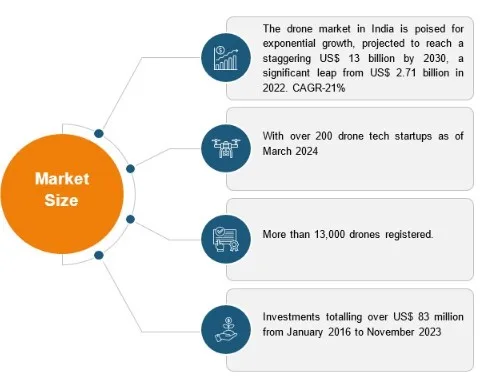Syllabus :GS 3/Economy
In News
- Farmers in Bhagthala Khurd, Kapurthala, and Amritsar are using drones for spraying pesticides on their maize and moong crops
| Do you know ? – Drones, or unmanned aerial vehicles (UAVs), are computerized flying vehicles that can operate autonomously or be controlled remotely. – Drones use GPS for route planning and navigation. – They can be managed through remote operators for precise control. – Drones can be equipped with various sensors, including: 1. Spectral Cameras: For capturing detailed images across different wavelengths. 2. Thermal Imaging Units: For monitoring temperature variations in crops. 3. LiDAR Systems: For creating high-resolution maps and 3D models of fields. |
Drone Technology in Agriculture
- The Indian drone market for agriculture is in its initial stages but shows promising growth.
- In Punjab, 93 out of 100 drones made available to farmers by the Indian Farmers Fertiliser Cooperative (IFFCO) under the Centre’s ‘NAMO Drone Didi’ scheme are already operational.
- These drones cost Rs 16 lakh each, and come equipped with 12-litre water tanks.

Benefits
- Health Protection: Drones reduce farmers’ direct exposure to harmful pesticides, which can lead to serious health issues like cancer and kidney ailments.
- Efficiency: Drones complete spraying tasks in 5-7 minutes per acre, compared to several hours manually.
- They also ensure uniform application, improving crop yields.
- Data from drones helps identify areas needing attention, which can lead to improved crop yields and increased profits.
- Nano Fertilisers: Drones handle nano fertilisers efficiently, ensuring uniform application of small quantities that are otherwise challenging to spread manually.
- Pest Control: Drones provide timely and effective application during pest infestations like pink bollworm, locusts, and whiteflies.
- Environmental Benefits: Drones can increase nutrient absorption from nano fertilisers to up to 90%, reducing runoff and pollution.
- Leaf-based application is less polluting than soil-based methods.
- Water Conservation: Drones cut down water use by up to 90% compared to traditional pesticide application methods.
- Reduced Costs: Drones minimize the need for manual labor and reduce pesticide and chemical usage, lowering overall costs.
- Additional Uses: Drones are also being used for dropping seed balls (soil and cow dung balls with seeds) for potential reforestation projects.
Challenges of Adopting Drone Technology
- Job Loss: The use of drones may lead to reduced demand for manual labor, impacting job opportunities for laborers.
- Lack of Knowledge and Training: Farmers may lack the necessary skills and training to operate drones effectively.
- Cost: The high cost of drones can be a barrier for many farmers.
- Regulatory Barriers: There may be regulatory challenges that complicate the adoption of drones in agriculture.
Initiatives:
- The Digital India campaign aims to improve digital infrastructure and provide training.
- Organizations like the Indian Council of Agricultural Research (ICAR) are promoting precision agriculture technologies, including drones.
- Production linked incentive (PLI) scheme: This scheme offers a considerable financial push of Rs. 120 crore (US$ 14.39 million) to incentivise domestic drone manufacturing and reduce import reliance.
- Sub-mission on agricultural mechanization (SMAM): This initiative provides financial aid to farmers who purchase drones, making this technology more accessible.
- The Government of India has launched the Namo Drone Didi Scheme with an aim to empower the women Self Help Groups (SHGs) and to provide access to modern agricultural technology.
- Support and Training: Efforts are being made to provide necessary training and support to farmers to overcome barriers to drone adoption.
Conclusion and Way Forward
- Drone technology has the potential to revolutionize agriculture by enhancing efficiency, yields, and cost-effectiveness.
- Drones may revolutionise pesticide or fertiliser application in Punjab fields, which has traditionally been carried out manually either by hired labourers or the farmers themselves.
- Therefore It is crucial for farmers and policymakers to collaborate to address challenges and ensure that the benefits of drones are realized while mitigating any concerns.
Source:IE
Previous article
GDP Growth Rate to Five-Quarter Low of 6.7%
Next article
News In Short – 31-08-2024